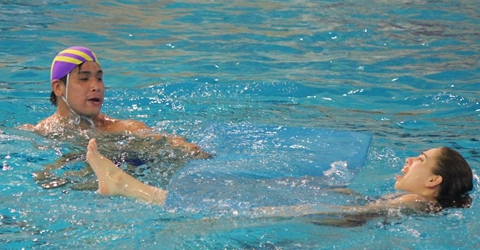The Ladder Approach: a step-by-step procedure for successful rescues
Aquatic rescues do not happen the way they are pictured in action movies. In reality, the fearless heroes who throw themselves into water to rescue a victim actually endanger their own life.

Aquatic rescues must always be done according to the Ladder Approach in order to reduce as many risks as possible and to prevent lifeguards from becoming victims. This approach presents, in order of increasing risk, the various alternatives the lifeguard can choose to rescue someone who is drowning. The key is to always choose the rescue technique that involves the lowest level of risk.
The key to success: minimizing risks
The first step is to encourage the victim to go to a safe location. If this does not work, try extending or throwing them a buoyant object; if the victim is close enough, a towel might do the trick. If the victim is far from you, throw a flotation device or buoyant aid that is preferably attached to a rope, so you can pull the victim towards you once they have grabbed the object.
If the victim is too far away from you, you can use a boat to get close enough to throw a buoyant object. If there is no boat, you can swim to the victim to provide them with a buoyant aid.
Contact rescues
Contact rescues are necessary when the victim is unable to get to a safe location, even with a buoyant object; you therefore must tow them by pulling the other end of the object. This indirect contact gets you nearer to the victim and increases the risks involved.
As a last resort, swim to the victim and carry them to a safe location. Rescue techniques that require a direct contact with the victim involve a lot more risks, since distressed victims can try to cling onto the lifeguard to get the support they need. Keeping a cool head and staying calm and cautious is your most important asset when rescuing someone.
The Ladder Approach’s eight rungs
1- Talk: Without going into the water, encourage the victim to get to safety by swimming towards the side of the pool or the shore.
2- Throw: Throw a buoyant aid to the victim from the side of the pool or the shore, and calmly talk to them while bringing them back to safety.
3- Reach: From a dry, safe location, extend or throw a rescue object to the victim and pull them to safety. The object may be buoyant or non-buoyant and should be attached to a rope.
4- Wade: Wade into shallow water and extend a rescue aid to the victim, or enter deep water while holding onto a solid object and throw the rescue aid.
5- Row: If one is available, use a watercraft and row to the victim until you are close enough to extend a rescue object while staying in the craft.
6- Swim: If there is no watercraft you can use, swim to the victim and provide them with a buoyant aid. Calmly talk to them while bringing them back to safety without making direct or indirect contact. It is important to push the buoyant aid towards the victim; panic-stricken victims may try to grab onto you, thus endangering you.
7- Tow: If the victim is unable to go to a safe location without additional help, even while hanging onto a buoyant aid, tow them by pulling the other extremity of the object. Make sure you can quickly move away from the victim to ensure your own safety.
8- Carry: Swim to the victim and carry them to safety. Choose this technique as a last resort, since direct contact rescues are the most dangerous ones for lifeguards.





